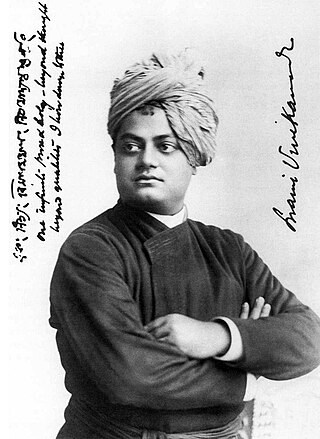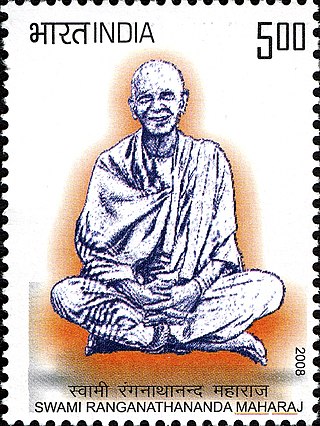
Swami Vivekananda, born Narendranath Datta, was an Indian Hindu monk, philosopher, author, religious teacher, and the chief disciple of the Indian mystic Ramakrishna. He was a key figure in the introduction of Vedanta and Yoga to the Western world; and is credited with raising interfaith awareness, and bringing Hinduism to the status of a major world religion. Vivekananda became a popular figure after the 1893 Parliament of Religions in Chicago, where he began his famous speech with the words, "Sisters and brothers of America...," before introducing Hinduism to Americans. He was so impactful at the Parliament that an American newspaper described him as, “an orator by divine right and undoubtedly the greatest figure at the Parliament”. After great success at the Parliament, in the subsequent years, Vivekananda delivered hundreds of lectures across the United States, England and Europe, disseminating the core tenets of Hindu philosophy, and founded the Vedanta Society of New York and the Vedanta Society of San Francisco, both of which became the foundations for Vedanta Societies in the Western world.

Ramakrishna Mission (RKM) is a Hindu religious and spiritual organisation which forms the core of a worldwide spiritual movement known as the Ramakrishna Movement or the Vedanta Movement. The mission is named after and inspired by the Indian spiritual Guru Ramakrishna Paramahamsa and founded by Ramakrishna's chief disciple Swami Vivekananda on 1 May 1897. The organisation mainly propagates the Hindu philosophy of Vedanta–Advaita Vedanta and four yogic ideals– Jnana, Bhakti, Karma, and Raja yoga.

Swami Ranganathananda was a Hindu swami of the Ramakrishna Math order. He served as the 13th president of the Ramakrishna Math and Mission.

Swami Yatiswarananda was a vice-president of Ramakrishna Order, whose headquarter is in Belur Math. He was a disciple of Swami Brahmananda, a brother disciple of Swami Vivekananda and a direct disciple and spiritual son of Ramakrishna. He served in Philadelphia propagating the message of Vedanta. He was the president of Bangalore centre of Ramakrishna Math. He founded an ashrama in Switzerland.

Belur Math is the headquarters of the Ramakrishna Math and Ramakrishna Mission, founded by Swami Vivekananda, the chief disciple of Ramakrishna Paramahamsa. It is located on the west bank of Hooghly River, Belur, West Bengal, India. The temple is the heart of the Ramakrishna movement. It is notable for its architecture that fuses Hindu, Islamic, Buddhist, and Christian art and motifs as a symbol of unity of all religions. In 2003, Belur Math railway station was also inaugurated which is dedicated to Belur Math Temple.

Sister Nivedita was an Irish teacher, author, social activist, school founder and disciple of Swami Vivekananda. She spent her childhood and early youth in Ireland. She was engaged to marry a Welsh youth, but he died soon after their engagement.

Ramakrishna Math is the administrative legal organization of the Ramakrishna Order, considered part of the Hindu reform movements. It was set up by sanyasin disciples of Ramakrishna Paramhansa headed by Swami Vivekananda at Baranagar Math in Baranagar, a place near Calcutta, in 1886. India. The headquarters of Ramakrishna Math and its twin organisation, Ramakrishna Mission is at Belur Math.

Sri Ramakrishna Vidyashala is a residential school for boys run by the Ramakrishna Mission. It is situated in the southern Indian city of Mysore in Karnataka. It offers a comprehensive education from high school to junior college, or grades eight through twelve. Basically focusing on All-round development of a child. Its former Correspondent, Swami Muktidananda, stated in May 2010: "Sri Ramakrishna Vidyashala accords preference to students from rural areas and economically and socially underprivileged background at the time of admission ... The student profile is divergent and reflective of the entire state of Karnataka."

Subodhananda, born as Subodh Chandra Ghosh, was a direct monastic disciple of Ramakrishna, the 19th-century saint and mystic from India. The youngest of the direct monastic disciples, he was affectionately known by his brother monks, whose leader was Swami Vivekananda, as "Khoka". He played a pioneering role in establishing the Ramakrishna Math and the Ramakrishna Mission. He was one of the first group of trustees of the Belur Math appointed by Vivekananda in 1901, and was afterwards elected treasurer of the Ramakrishna Mission.

Swami Vivekananda was a Hindu monk from India. His teachings and philosophy are a reinterpretation and synthesis of various strands of Hindu thought, most notably classical yoga and (Advanta) Vedanta, with western esotericism and Universalism. He blended religion with nationalism, and applied this reinterpretation to various aspect's of education, faith, character building as well as social issues pertaining to India. His influence extended also to the west, and he was instrumental in introducing Yoga to the west.

Ramakrishna Math and Mission, Bhubaneswar is a monastic organization for men brought into existence by Ramakrishna (1836–1886), a 19th-century saint of Bengal. The motto of the Ramakrishna Math and Ramakrishna Mission is: "For one's own salvation, and for the welfare of the world". Sri Ramakrishna Math, Bhubaneswar is the first branch center of the Ramakrishna Order in Odisha. It was started in the year 1919 by Swami Brahmananda, one of the direct disciples of Ramakrishna. Besides Swami Brahmananda, the Math was visited by Swami Shivananda, Swami Premananda, Swami Niranjanananda, and Swami Vijnanananda.

Baranagar Math or Ramakrishna Math, Baranagar was the first monastery of Ramakrishna Order. In September 1886, after the death of Ramakrishna, when his devotees stopped funding, Swami Vivekananda and other disciples of Ramakrishna decided to make a dilapidated house at Baranagar their new math. The house crumbled to dust in 1897. In 1973 Vivekananda Math Samrakshan Samity was formed who attempted to preserve the area. In 2001, the possession was handed over to Belur Math authority, who soon-after declared it as one of their official branch. The restoration and development work of the area is still going on.

Bahujana sukhaya bahujana hitaya cha is a dictum or aphorism enunciated in the Rigveda in Sanskrit.
Meditation played a very important role in the life and teachings of Swami Vivekananda. He was interested in meditation from his childhood. His master Ramakrishna found him a dhyana - siddha . On 24 December 1892, Vivekananda reached Kanyakumari and meditated for three days on a large rock and took the resolution to dedicate his life to serve humanity. The event is known as the Kanyakumari resolve of 1892. He reportedly also meditated for a long time on the day of his death.

The relationship between Ramakrishna and Vivekananda began in November 1881, when they met at the house of Surendra Nath Mitra. Ramakrishna asked Narendranath to sing. Impressed by his singing talent, he invited him to Dakshineswar. Narendra accepted the invitation, and the meeting proved to be a turning point in the life of Narendranath. Initially Narendra did not accept Ramakrishna as his master and found him to be a "mono maniac", but eventually he became one of the closest people in his life. Ramakrishna reportedly shaped the personality of Narendranath and prepared him to dedicate his life to serve humanity. After the death of Ramakrishna, Narendra and his other monastic disciples established their first monastery at Baranagar.

Sarat Chandra Chakravarty was a direct householder disciple of Swami Vivekananda and was the chronicler of "Diary of a Disciple" which is one of the major sources of first-hand information on Vivekananda's biography and teachings in the later stage of his life. Sarat Chandra was intimately connected with the Ramakrishna Order throughout his life, and even before the return of Swami Vivekananda from the West in 1897 he had been associated with the old monastery in Alambazar and with the direct disciples of Sri Ramakrishna. He was also a Sanskrit scholar and was a postmaster by profession in the British Government service.

Ramakrishna Mission Sevashrama is a branch of Ramakrishna Math and Ramakrishna Mission involved in providing humanitarian, healthcare, education and relief services to poor and needy through the universal principle of serving "God in man", based on the motto, Atmano Moksartham Jagat Hitaya Cha, which was propounded by Swami Vivekananda.

Ramakrishna Mission Sevashrama, Kankhal (RKMS) is in its present form is a 210-bed multi-specialty charitable hospital in Kankhal, Haridwar in Uttarakhand. It is a branch of Ramakrishna Mission, and was established in 1901 by Swami Kalyanananda, one of the direct monastic disciples of Swami Vivekananda. The hospital serves the treatment needs of poor patients in and around Uttarakhand. Since its inception it has treated more than 10 million patients. From a modest beginning in a rented two room dilapidated building it has grown to be a multi-specialty hospital for treatment of impoverished and needy people, under the supervision of the monks of Ramakrishna Order. The hospital is located in an 18 acres campus, and houses Gynecology and Obstetrics, Pediatrics, Intensive Care Units, Pathological laboratory, Blood bank, Operation Theaters etc. in addition to dairy and agricultural land whose products are used for the consumption of poor in patients.

Ramakrishna Math, Ulsoor is a branch of Ramakrishna Math and Ramakrishna Mission located at Ulsoor, Bangalore, India. Other than Ulsoor, there is another Ramakrishna Mission branch in Bangalore located at Bull Temple Road.
Sri Sarada Math is named after Sri Sarada Devi, the consort of Sri Ramakrishna, and founded on 2 December 1954. Built by a group of eight sadhavis, as per the instructions given by Swami Vivekananda, it serves as a monastic order for women. Headquartered at Dakshineshwar, Kolkata, the organisation has branch centres all over India, in Sri Lanka and Australia. The nuns of this order use the title "Pravrajika" before their ordained name, and are usually addressed as "Mataji" meaning 'revered mother'.















